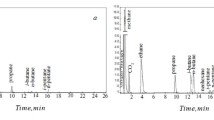Summary
The paper discusses the effects of the flow rate and the nature of the carrier gas, and the value of the Henry temperature coefficient on the capacity and effciency of preparative gas-solid adsorption columns.
The theoretical relationship between the height equivalent of a theoretical plate (HETP) and the experimental parameters under overloaded conditions was obtained byDe Wet andPretorius [1] and somewhat modified by us [2]. Although it was derived under the assumption that the sorption isotherm is linear, the equation was shown to be in qualitative agreement with the experimental results when the separation took place in a partition column.
Consequently we investigated the applicability of this equation for separation on gas-solid adsorption columns containing modified silica, further the optimum characteristics of the adsorbents and the optimal separation conditions. The dependence of the capacity on the separation conditions, theoretically derived by us in an earlier paper [3] has also been studied.
Zusammenfassung
Die Arbeit befaßt sich mit der Wirkung von Strömungsgeschwindigkeit und Art des Trägergases, sowie mit dem Wert des Temperatur-Koeffizienten nach Henry auf die Kapazität und Wirksamkeit von Adsorptionssäulen für die präparative Fest-Gas-Chromatographie. Die theoretische Beziehung zwischen Bodenzahl (HETP) und Versuchsbedingungen bei Überladung wurde vonDe Wet undPretorius [1] emittelt und von uns etwas abgewandelt [2]. Obwohl sie unter der Voraussetzung einer linearen Adsorptionsisotherme abgeleitet wurde, zeigte die Gleichung gute Übereinstimmungmit den experimentell erhaltenen Ergebnissen bei der Trennung in einer Verteilungssäule. Daraufhin untersuchten wir die Anwendbarkeit dieser Gleichung für Trennungen auf Adsorptionssäulen für die Gas-Fest-Chromatographie, die mit modifiziertem Silicagel gefüllt waren; weiterhin versuchten wir die optimalen Eigenschaften der Adsorbentien und die optimalen Trennbedingungen zu ermitteln. Die Abhängigkeit der Belastbarkeit von den Trennbedingungen, die in einer früheren Arbeit [3] von uns schon theoretisch abgeleitet worden war, wurde ebenfalls untersucht.
Résumé
Dans ce travail on étudie les effets de la vitesse, de la nature du gaz vecteur, ainsi que de la valeur du coefficient de température selon Henry, sur la capacité et l'efficacité de colonnes adsorbantes en chromatographie préparative gaz-solide. La relation théorique entre la hauteur équivalente d'un plateau théorique (HETP) et les paramètres expérimentaux, dans des conditions de surcharge, a été établie parDe Wet etPretorius [1] et légèrement modifiée par nous [2]. Bien que cette relation füt obtenue en supposant que l'isotherme d'adsorption est linéaire, on trouve une bonne concordance qualitative avec les résultats expérimentaux de la chromatographie de partage. Par conséquent nous avons étudié la validité de cette équation pour des séparations sur colonnes adsorbantes en chromatographie gaz-solide (silice modifié); en outre nous avons essayé d'établir les caractéristiques optimales des adsorbants et les conditions de séparation optimales. On a étudié la relation existant entre la capacité et les conditions de séparation, en tenant compte des équations théoriques établies par nous dans un travail antérieur [3].
Similar content being viewed by others
References
W. J. DeWet, V. Pretorius, Analyt. Chem.,32, 169, (1960).
K. I. Sakodynskii, S. A. Volkov, J. Chromatogr.,49, 76, (1970).
S. A. Volkov, K. I. Sakodynskii, Chromatographia (in press).
J. J. Van Deemter, F. J. Zuiderweg, A. Klinkenberg, Chem. F.ngng. Sci.5, 271, (1956).
K. V. Alexeeva, A. A. Zhukhovitskii, N. M. Turkel'taub, Neftekhimiya,2, No. 6, 934, (1962).
M. Verzele, J. Chromatogr.,15, 482, (1964).
J. C. Giddings, Analyt Chem.6, 1170, (1964).
R. H. Perrett, I. H. Purnell, Analyt. Chem.,35, 430, (1963).
T. Kambara, H. Kodama, J. Chromatogr.,17, 66, (1965).
W. E. Harris, H. W. Habgood, Programmed Temperature Gas Chromatography. J. Wiley and Sons Inc., New York, N.Y. 1966.
Author information
Authors and Affiliations
Rights and permissions
About this article
Cite this article
Zel'venskii, V.Y., Sadodynskii, K.I. & Volkov, S.A. Preparative gas-solid adsorption chromatography. Part II. Selection of optimal conditions for separation in preparative chromatography. Chromatographia 5, 271–277 (1972). https://doi.org/10.1007/BF02268586
Received:
Accepted:
Issue Date:
DOI: https://doi.org/10.1007/BF02268586




